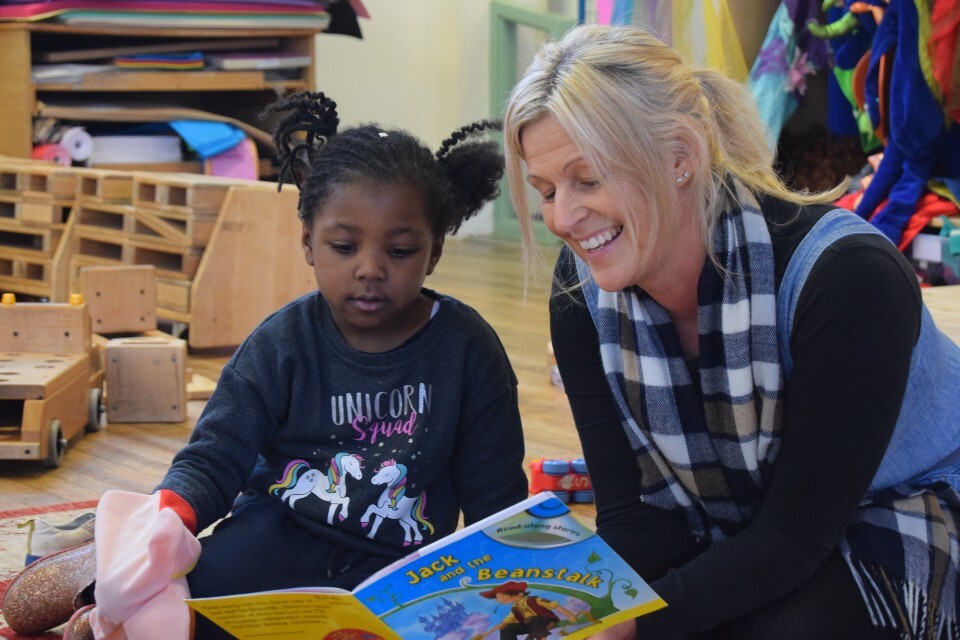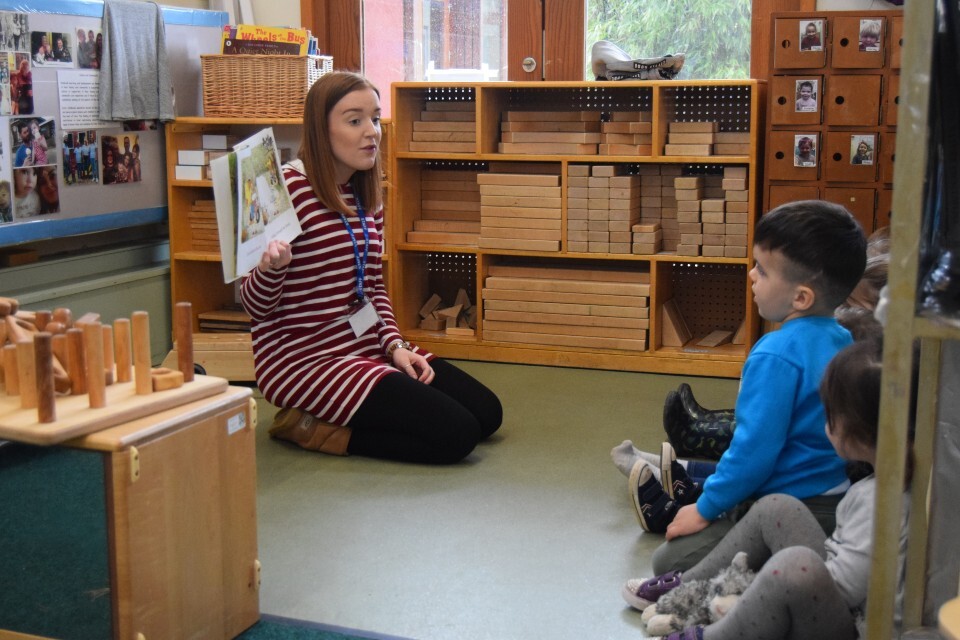Reading comprehension
Find ways to build reading comprehension in early years children to raise their concentration and focus.
Contents on this page
Why reading comprehension is important
Oral language development is key to children’s development. Language development can be enhanced by the amount of spoken language a child hears and joins in with. Language comprehension is an important pre-requisite to children being able to understand what they read for themselves, when the teaching of phonics begins in reception. It’s also important to later success with writing composition.
Language development links closely to listening and understanding. Introducing children to a wide range of words they would rarely hear or use increases their knowledge of vocabulary and concepts to help them understand the world around them. Hearing and talking about these words in context helps children to understand.
Through reading with children you talk about the meanings of words. This starts with you providing and talking about the children’s interests and gradually extending their knowledge about the world around them.
Listening to stories introduces children to words they would not often hear in everyday speech. It also gives them an awareness of sentence structure.
You should provide a wide range of reading experiences to help children develop a love of reading, curiosity and wonder about the world around them. Providing a well sequenced reading curriculum to develop children’s knowledge of language and how it works, can create fluent, passionate and lifelong readers.
Video
In this video, an early years expert explains the importance of reading comprehension in the early years foundation stage framework. There are also some tips on how to support children in this area.
What the EYFS framework says
Language comprehension (necessary for both reading and writing) starts from birth. It only develops when adults talk with children about the world around them and the books (stories and non-fiction) they read with them, and enjoy rhymes, poems and songs together.
Statutory framework for the early years foundation stage.
What this means in practice
You should begin by looking at what you want children to learn and then identify how you can provide experiences that allow children to develop their early comprehension skills.
Adults share books with babies. They may just look at a favourite page or picture. When reading to young children, help them ‘read the picture back’ by letting them grab the book or point to the picture.
By providing children with a wide selection of reading material, children can be supported to choose books for themselves. Adults can talk about why they like a book and share what the child likes too. You should let them explore how books open, while talking about what they see or feel. Be patient, letting them ask or answer questions.
Through the regular sharing of books, the children will become more interested in books, and be able to explain what they are about. You should help them guess what happens next. Make the text come alive by using voices, exaggerated facial expressions and body movements to tell the story.
Providing lots of opportunities for children to make their own books, such as a family books, helps children to begin to understand that written words have meanings. This helps them to start to understand print has meaning and that it works from left to right, and top to bottom.
Suggested activities
Reading aloud with children

You’ll need books the children enjoy. Choosing books that include words that children and adults would be unlikely to use in speech can be particularly helpful.
Before reading think about:
- what the children already know
- which words they are practising or using for the first time
- if they will recognise the book’s language, for example, story markers, ‘once upon a time’, ‘one day’
Sit in a cosy place with your children and as you read with them:
- ask ‘why have I, you or we chosen this book?’
- tell them why you like it, for example ‘I love this book because the cat always makes me laugh’
- point out colours, pictures and characters
- challenge them to point out the book’s title, or author
- stop and talk about the main characters
- look for rhymes, like ‘shark in the park’
When you are reading it helps to be enthusiastic and exaggerate your movements.
Young children might look at one picture, or just part of a book. Older children could use finger or stick puppets to act out the story, or act it out themselves.
Ask children about some of the main points, for example ‘have you seen one of these animals before?’ Provide related toys or equipment, such as musical instruments, a magnifying glass or toy animal.
Think of similar, new words you could use. For example, when hunting a bear ‘what else does walking through mud sound like?’.
How the activity links to the other areas of learning
Reading and talking about books, while asking and answering questions about them (communication and language). Talking to children about what they know (personal, social and emotional development). Talking about words and rhyme (exploring words). Looking at pictures, and talking about them (expressive arts and design).
Reading book groups

You’ll need books the children enjoy. Some suggested titles are:
Traditional tales:
- ‘Three little pigs’, original
- ‘Three little wolves’ and the ‘Big bad pig’, by Eugene Triviza and Helen Oxenbury
- ‘Each peach pear plum’, by Janet and Allan Ahlber
Rhyming books:
- ‘Pigeon poo’, by Elizabeth Baguley and Mark Chambers
- ‘A is amazing’, edited by Wendy Cooling
- ‘Odd socks’, by Rebecca Ashdown
Books containing letters:
- ‘The Jolly Postman’ or ‘Other peoples’ letters’, by Janet and Allan Ahlberg
- ‘Snail mail’ (with pull-out postcards), by Sharon King- Chan
Wordless books:
- ‘Mirror,’ by Jeannie Baker
- ‘Knock knock’, by Kaori Takahashi
Develop children’s conversation and vocabulary by talking with them as they read.
Arrange book groups attractively in your reading area.
Invite children to share a book together. Ideally, it would link to something the child has done recently, or what they imagined, watched or explored.
Explore the book’s front and back, noticing any pictures or words that might help guess what happens inside.
Talk to children while turning the pages, asking what they think might happen next. Get them to ‘read to you’, or say what they think is happening. It does not matter if they don’t get it exactly, or if parts are missed.
Sensitively point out words or pictures, asking and waiting for feedback. ‘Do you like this story, picture, character?’ ‘Why? Why not?’. Talk about their responses.
How the activity links to the other areas of learning
The children could explain what they like or dislike and why (personal, social and emotional development). Children could comment or expand on a story (communication and language) and holding books and turning pages encourages physical development. When children come across numbers and shapes in context this supports mathematics. Books are a way of exploring the world beyond their own environment (understanding the world). Reading enhances imagination and creativity (expressive arts and design).
Other activities
Booktrust has suggested children’s books and book lists, advice and games.
BBC Nursery songs is a bank of songs and nursery rhymes that focus on comprehension.
The Centre for Literacy in Primary Education has activities that are suitable for early years.
Resources from Love my books helping parents and young children enjoy sharing books together.
What other nurseries and childminders are doing
“Reading is a huge part of our everyday nursery routine. Allowing children to get engrossed in books, using illustrations and props to enhance how they follow a story, gives children confidence to ‘have a go’. This confidence carries over to many other learning areas, sparking imagination, curiosity and joining in related tasks such as roleplay. All these skills are paramount in supporting early years children’s comprehension. We make our book areas cosy and inviting, offering a range of different book types. Offering this supports each child’s individual learning needs.”
Emma, Newbury Gardens Day Nursery, West Berkshire.
Summary
- Reading is a necessary, lifelong skill.
- Being read to provides comfort for children, improving their concentration and focus.
- Being read to gives children knowledge to understand and talk about the world around them.
- When children understand what is being read this helps them understand how words, phrases and sentences are put together.
- Using and sharing fiction and non-fiction books, poems, rhymes and songs builds children’s understanding and use of language.
Next steps
- Have a good look through all your books or look at what can be borrowed from local libraries checking which ones work for you.
- Use books that support question development, helping children improve their understanding of what’s happening.
- Make sure your book choices give you lots to talk about and enjoy with your children.
- Choose books for different purposes, for example to extend vocabulary, get an emotional response or broaden their experiences of real or imagined worlds.
- Repeat readings of the same stories with the children.
- Discuss favourite books with your colleagues or other providers. Compare notes, and exchange ideas. Ask which ones they use, and why.
